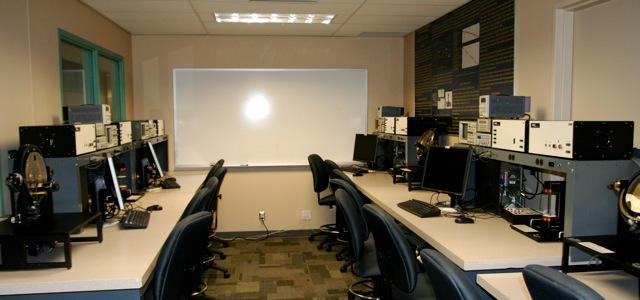
Control Systems Laboratory
The control-systems laboratory (CSL) is housed within the College of Engineering and Applied Science at the University of Colorado at Colorado Springs. Its mission is to support teaching and research in control-system theory within the Electrical and Computer Engineering (ECE) and Mechanical and Aerospace Engineering (MAE) programs.The lab comprises a number of student and research work centers. Each work center has at least one device to control, which include Educational Control Products' (ECP) Magnetic Levitation and Control-Moment Gyroscope systems and a Rhino Robotics six-degree-of-freedom robotic arm. Each center has a full complement of test-and-measurement equipment.
The dynamic devices may be configured to study identification and control of linear or nonlinear, stable or unstable, SISO, collocated SIMO, noncollocated SIMO and full MIMO control. Control is accomplished using Comdyna GP-6 analog computers or a digital computer via MathWorks' Matlab/ Simulink/ the Real Time Workshop and Quanser QUARC.
The laboratory provides opportunities for undergraduate and graduate student research in all aspects of control systems. The lab supports undergraduate analog and digital control-systems lab courses, and projects in both undergraduate and graduate control-systems courses. For further information on opportunities for undergraduate and graduate students, please contact Dr. Gregory L. Plett at [email protected]. Funding sources for the CSL have included substantial discounts from ECP, as well as a grant from the National Science Foundation.
The following laboratory courses use the CSL:
- ECE4530: Feedback Control Laboratory
The lab reader is also available (78-page pdf file, 2.8 Mb, requires Adobe Acrobat Reader). (This material is based upon work supported by the National Science Foundation under Grant No. 9981009. Any opinions, findings, and conclusions or recommendations expressed in this material are those of the author and do not necessarily reflect the views of the National Science Foundation.)
- ECE4560: Digital Control Laboratory
The lab reader is also available (82-page pdf file, 1.2 Mb, requires Adobe Acrobat Reader).
(This material is based upon work supported by the National Science Foundation under Grant No. 9981009. Any opinions, findings, and conclusions or recommendations expressed in this material are those of the author and do not necessarily reflect the views of the National Science Foundation.)
- ECE4510/5510: Feedback Control Systems
- ECE4520/5520: Multivariable Control Systems I
- ECE4540/5540: Digital Control Systems
- ECE5560: System Identification
- ECE5590: Model Predictive Control
The following papers have been written describing the CSL and its implementation:
- Plett, G., Schmidt, D. ``Multidisciplinary Lab-Based Controls Curriculum,'' Proceedings of the 2001 American Society for Engineering Education Annual Conference & Exposition, CDROM proceedings, June 24-27 2001.
- Plett, G., Schmidt, D. ``A Multidisciplinary Digital Control-Systems Laboratory,'' Proceedings of the 2002 American Society for Engineering Education Annual Conference & Exposition, CDROM proceedings, June 2002.


